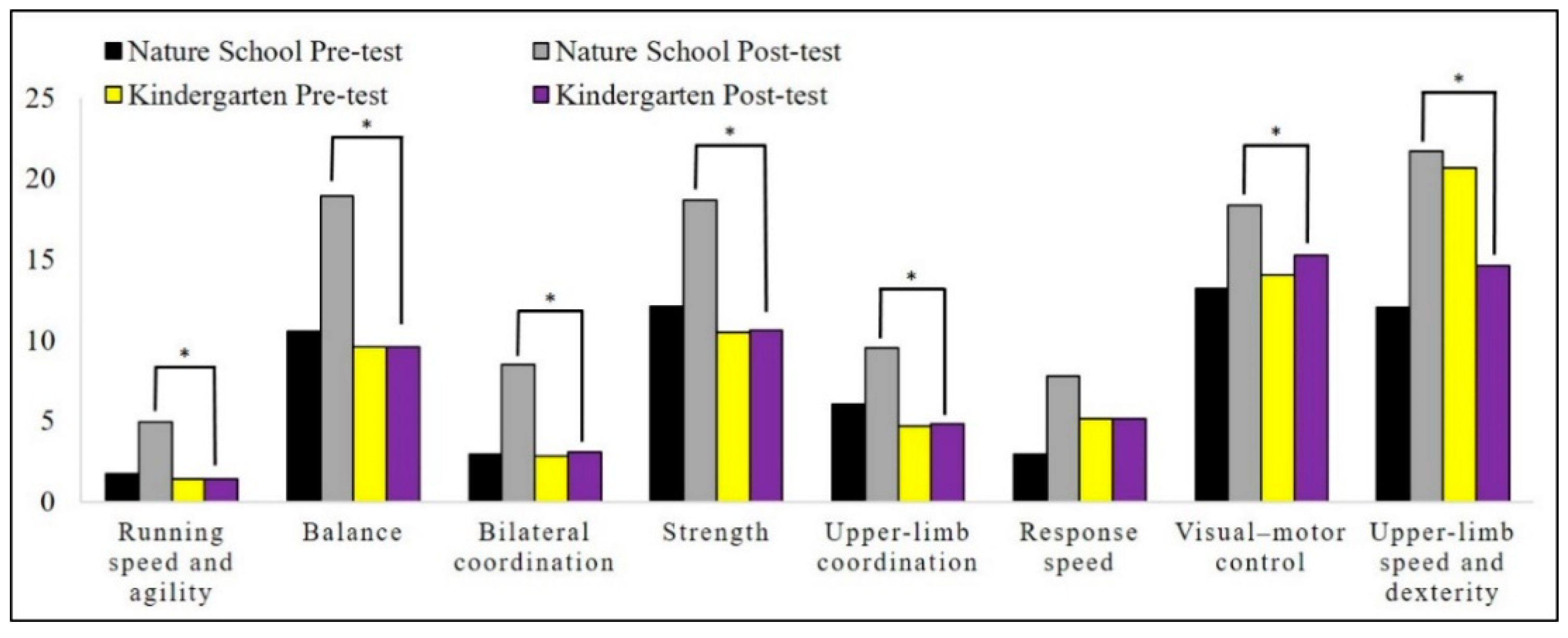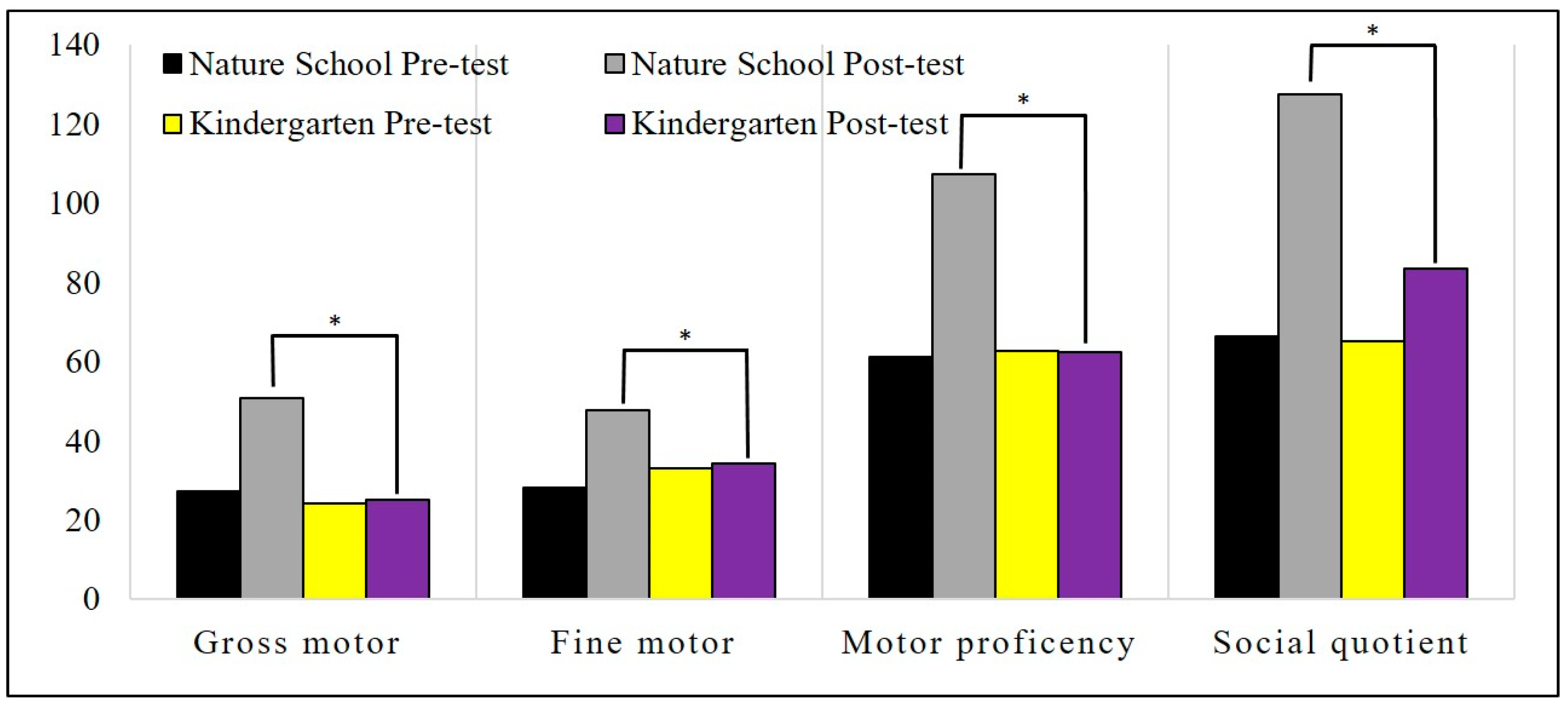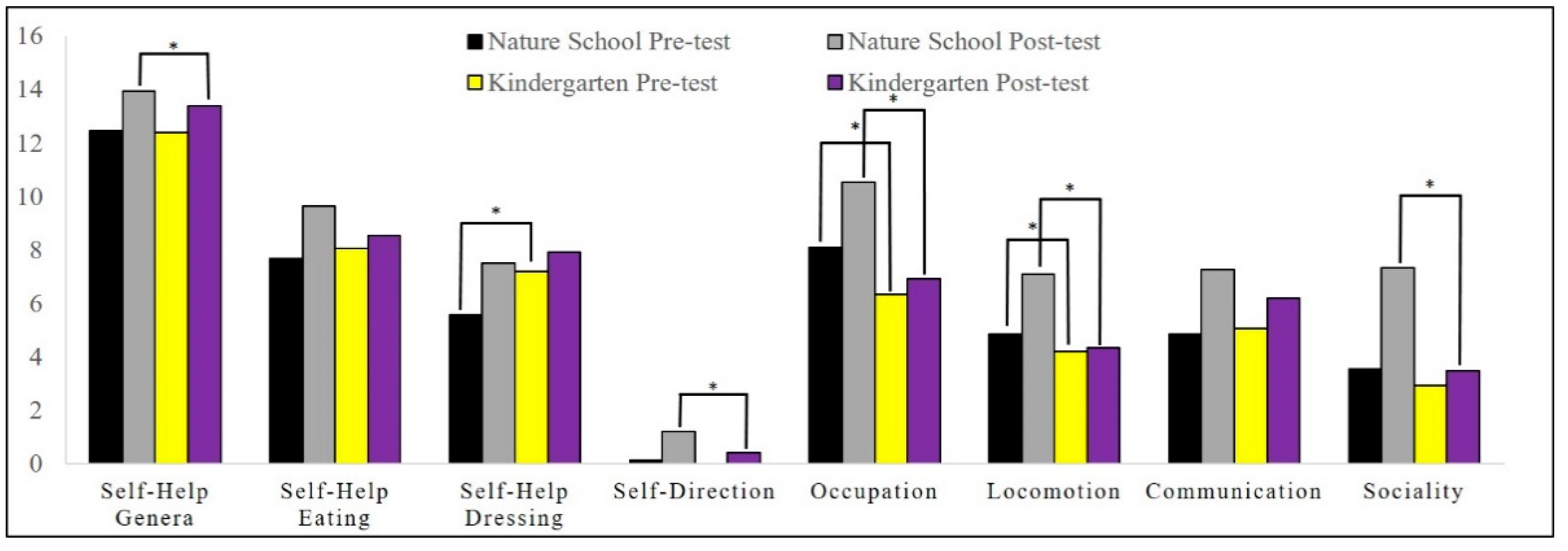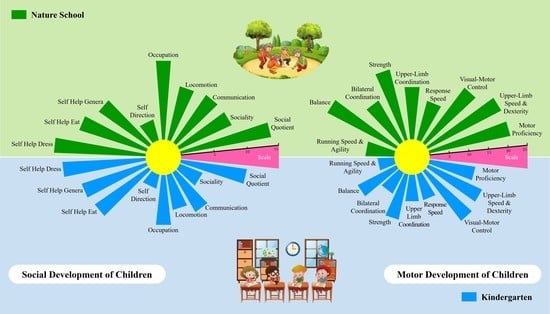The Effect of Environmental Contexts on Motor Proficiency and Social Maturity of Children: An Ecological Perspective
Abstract
1. Introduction
2. Materials and Methods
2.1. Subjects and Design
2.2. Procedure
2.3. Instruments
2.4. Data Analysis
3. Results
4. Discussion
4.1. MotorProficiency at Nature Schools vs. Kindergartens
4.2. Social Maturity at Nature Schools vs. Kindergartens
4.3. Limitations and Suggestions
5. Conclusions
Author Contributions
Funding
Institutional Review Board Statement
Informed Consent Statement
Data Availability Statement
Acknowledgments
Conflicts of Interest
References
- Christian, H.; Ball, S.J.; Zubrick, S.R.; Brinkman, S.; Turrell, G.; Boruff, B.; Foster, S. Relationship between the neighborhood built environment and early child development. Health Place 2017, 48, 90–101. [Google Scholar] [CrossRef]
- Pem, D. Factors affecting early childhood growth and development: Golden 1000 days. Adv. Pract. Nurs. 2015, 1. [Google Scholar]
- Osher, D.; Cantor, P.; Berg, J.; Steyer, L.; Rose, T. Drivers of human development: How relationships and context shape learning and development1. Appl. Dev. Sci. 2020, 24, 16–36. [Google Scholar] [CrossRef]
- Firoozjah, M.H.; Sheikh, M.; Hemayattalab, R.; Shahrbanian, S. The influence of environment potentiality (affordances) on motor development in 6–9 years old children with intellectual disability. Sport Sci. Health 2019, 15, 497–502. [Google Scholar] [CrossRef]
- Barandiaran, A.; Muela, A.; Arana, E.L.; Larrea, I.; Vitoria, J.R. Exploratory behaviour, emotional wellbeing and childcare quality in preschool education. Anales de Psicología 2015, 31, 570–578. [Google Scholar] [CrossRef]
- Bidzan-Bluma, I.; Lipowska, M. Physical activity and cognitive functioning of children: A systematic review. Int. J. Environ. Res. Public Health 2018, 15, 800. [Google Scholar] [CrossRef] [PubMed]
- Storli, R.; Sandseter, E.B.H. Children’s play, well-being and involvement: How children play indoors and outdoors in Norwegian early childhood education and care institutions. Int. J. Play 2019, 8, 65–78. [Google Scholar] [CrossRef]
- Storli, R.; Sandseter, E.B.H.; Sando, O.J. Children’s Involvement in Free Play and the Use of Play Materials in the Outdoor Early Childhood Education and Care Environment. Child. Youth Environ. 2020, 30, 66–82. [Google Scholar] [CrossRef]
- Sando, O.J.; Sandseter, E.B.H. Affordances for physical activity and well-being in the ECEC outdoor environment. J. Environ. Psychol. 2020, 69, 101430. [Google Scholar] [CrossRef]
- Ethier, S. Developmental Benefits of Play on a Natural Playground. 2017. Available online: http://hdl.handle.net/1828/8057 (accessed on 21 January 2020).
- Van Dijk-Wesselius, J.; Maas, J.; Hovinga, D.; Van Vugt, M.; Van den Berg, A. The impact of greening schoolyards on the appreciation, and physical, cognitive and social-emotional well-being of schoolchildren: A prospective intervention study. Landsc. Urban Plan 2018, 180, 15–26. [Google Scholar] [CrossRef]
- Maddison, R.; Vander Hoorn, S.; Jiang, Y.; Mhurchu, C.N.; Exeter, D.; Dorey, E. The environment and physical activity: The influence of psychosocial, perceived and built environmental factors. Int. J. Behav. Nutr. 2009, 6, 1–10. [Google Scholar] [CrossRef]
- Czalczynska-Podolska, M. The impact of playground spatial features on children’s play and activity forms: An evaluation of contemporary playgrounds’ play and social value. J. Environ. Psychol. 2014, 38, 132–142. [Google Scholar] [CrossRef]
- Henderson, K.E.; Grode, G.M.; O’Connell, M.L.; Schwartz, M.B. Environmental factors associated with physical activity in childcare centers. Int. J. Behav. Nutr. 2015, 12, 43. [Google Scholar] [CrossRef]
- Wang, X.; Woolley, H.; Tang, Y.; Liu, H.Y.; Luo, Y. Young children’s and adults’ perceptions of natural play spaces: A case study of Chengdu, southwestern China. Cities 2018, 72, 173–180. [Google Scholar] [CrossRef]
- Oswald, T.K.; Rumbold, A.R.; Kedzior, S.G.; Moore, V.M. Psychological impacts of “screen time” and “green time” for children and adolescents: A systematic scoping review. PLoS ONE 2020, 15, e0237725. [Google Scholar]
- Ferguson, K.T.; Cassells, R.C.; MacAllister, J.W.; Evans, G.W. The physical environment and child development: An international review. Int. J. Psychol. 2013, 48, 437–468. [Google Scholar] [CrossRef]
- Hoglund, W.L.; Leadbeater, B.J. The effects of family, school, and classroom ecologies on changes in children’s social competence and emotional and behavioral problems in first grade. Dev. Psychol. 2004, 40, 533. [Google Scholar] [CrossRef] [PubMed]
- Feldman, R. Bio-behavioral synchrony: A model for integrating biological and microsocial behavioral processes in the study of parenting. Parenting 2012, 12, 154–164. [Google Scholar] [CrossRef]
- Callaghan, B.; Meyer, H.; Opendak, M.; Van Tieghem, M.; Harmon, C.; Li, A. Using a developmental ecology framework to align fear neurobiology across species. Annu. Rev. Clin. Psychol. 2019, 15, 345–369. [Google Scholar] [CrossRef] [PubMed]
- Wang, M.T.; Degol, J.L.; Henry, D.A. An integrative development in sociocultural-context model for children’s engagement in learning. Am. Psychol. 2019, 9, 1086–1102. [Google Scholar] [CrossRef] [PubMed]
- Gibson, J.J. The Ecological Approach to Visual Perception: Classic Edition; Psychology Press: New York, NY, USA, 2014. [Google Scholar]
- Lerstrup, I.; Konijnendijk van den Bosch, C. Affordances of outdoor settings for children in preschool: Revisiting heft’s functional taxonomy. Landsc. Res. 2017, 42, 47–62. [Google Scholar] [CrossRef]
- Flôres, F.S.; Rodrigues, L.P.; Copetti, F.; Lopes, F.; Cordovil, R. Affordances for Motor Skill Development in Home, School, and Sport Environments: A Narrative Review. Percept. Mot Ski. 2019, 126, 366–388. [Google Scholar] [CrossRef]
- Niemistö, D.; Finni, T.; Haapala, E.A.; Cantell, M.; Korhonen, E.; Sääkslahti, A. Environmental correlates of motor competence in children—the skilled kids study. Int. J. Environ. Res. Public Health 2019, 16, 1989. [Google Scholar] [CrossRef]
- Larrea, I.; Muela, A.; Miranda, N.; Barandiaran, A. Children’s social play and affordance availability in preschool outdoor environments. Eur. Early Child. Educ. Res. J. 2019, 27, 185–194. [Google Scholar] [CrossRef]
- Kyttä, M. Affordances of children’s environments in the context of cities, small towns, suburbs and rural villages in Finland and Belarus. J. Environ. Psychol. 2002, 22, 109–123. [Google Scholar] [CrossRef]
- Acar, H. Learning environments for children in outdoor spaces. Procedia Soc. Behav. Sci. 2014, 141, 846–853. [Google Scholar] [CrossRef]
- Shanahan, D.F.; Franco, L.; Lin, B.B.; Gaston, K.J.; Fuller, R.A. The benefits of natural environments for physical activity. Sports Med. 2016, 46, 989–995. [Google Scholar] [CrossRef]
- Gibson, J.J. The Ecological Approach to Visual Perception; Wiley: Boston, MA, USA, 1979. [Google Scholar]
- Bjørgen, K. Physical activity in light of affordances in outdoor environments: Qualitative observation studies of 3–5 years olds in kindergarten. Springerplus 2016, 5, 950. [Google Scholar] [CrossRef]
- Muela, A.; Larrea, I.; Miranda, N.; Barandiaran, A. Improving the quality of preschool outdoor environments: Getting children involved. Eur. Early Child. Educ. Res. 2019, 27, 385–396. [Google Scholar] [CrossRef]
- Dankiw, K.A.; Tsiros, M.D.; Baldock, K.L.; Kumar, S. The impacts of unstructured nature play on health in early childhood development: A systematic review. PLoS ONE 2020, 15, e0229006. [Google Scholar]
- Bento, G.; Dias, G. The importance of outdoor play for young children’s healthy development. Porto Biomed J. 2017, 2, 157–160. [Google Scholar] [CrossRef]
- Flegel, J.; Kolobe, T.H.A. Predictive validity of the Test of Infant Motor Performance as measured by the Bruininks-Oseretsky Test of Motor Proficiency at school age. Phys. Ther. 2002, 82, 762–771. [Google Scholar] [CrossRef]
- Wilson, B.N.; Kaplan, B.J.; Crawford, S.G.; Dewey, D. Interrater reliability of the Bruininks-Oseretsky test of motor proficiency–long form. Adapt. Phys. Act. Q. 2000, 17, 95–110. [Google Scholar] [CrossRef]
- Roopesh, B.N. Vineland Social Maturity Scale: An Update on Administration and Scoring. Indian J. Clin. Psychol. 2019, 46, 91–102. [Google Scholar]
- Miranda, N.; Larrea, I.; Muela, A.; Barandiaran, A. Preschool children’s social play and involvement in the outdoor environment. Early Educ. Dev. 2017, 28, 525–540. [Google Scholar] [CrossRef]
- Lysklett, O.B.; Berg, A.; Moe, B. Motor competence and physical fitness among children attending nature preschools and traditional preschools. Int. J. Play. 2019, 8, 53–64. [Google Scholar] [CrossRef]
- McClain, C.; Vandermaas-Peeler, M. Social contexts of development in natural outdoor environments: Children’s motor activities, personal challenges and peer interactions at the river and the creek. J. Adventure Educ. 2016, 16, 31–48. [Google Scholar] [CrossRef]
- Withagen, R.; Araújo, D.; Poel, H.J. Inviting affordances and agency. New Ideas Psychol. 2017, 45, 11–18. [Google Scholar] [CrossRef]
- Araújo, D.; Brymer, E.; Brito, H.; Withagen, R.; Davids, K. The empowering variability of affordances of nature: Why do exercisers feel better after performing the same exercise in natural environments than in indoor environments? Psychol. Sport Exerc. 2019, 42, 138–145. [Google Scholar] [CrossRef]
- Yıldırım, G.; Akamca, G.Ö. The effect of outdoor learning activities on the development of preschool children. S. Afr. J. Educ. 2017, 37, 2. [Google Scholar] [CrossRef]
- Gill, T. The benefits of children’s engagement with nature: A systematic literature review. Child. Youth Environ. 2014, 24, 10–34. [Google Scholar] [CrossRef]
- Breda, J.; Jakovljevic, J.; Rathmes, G.; Mendes, R.; Fontaine, O.; Hollmann, S.; Rütten, A.; Gelius, P.; Kahlmeier, S.; Galea, G. Promoting health-enhancing physical activity in Europe: Current state of surveillance, policy development and implementation. Health Policy 2018, 122, 519–527. [Google Scholar] [CrossRef]
- Maynard, T.; Waters, J. Learning in the outdoor environment: A missed opportunity? Early Years 2007, 27, 255–265. [Google Scholar] [CrossRef]
- Fjørtoft, I. The natural environment as a playground for children: The impact of outdoor play activities in pre-primary school children. Early Child. Educ. J. 2001, 29, 111–117. [Google Scholar] [CrossRef]
- Vygotsky, L.S. Mind in Society: The Development of Higher Psychological Processes; Harvard University Press: London, UK, 1980. [Google Scholar]
- Mustapa, N.D.; Maliki, N.Z.; Hamzah, A. Repositioning children’s developmental needs in space planning: A review of connection to nature. Procedia Soc. Behav. Sci. 2015, 170, 330–339. [Google Scholar] [CrossRef]
- Van Dijk, L.; Rietveld, E. Foregrounding sociomaterial practice in our understanding of affordances: The skilled intentionality framework. Front. Psychol. 2017, 7, 1969. [Google Scholar] [CrossRef] [PubMed]
- González-Valero, G.; Zurita-Ortega, F.; Lindell-Postigo, D.; Conde-Pipó, J.; Grosz, W.R.; Badicu, G. Analysis of Self-Concept in Adolescents before and during COVID-19 Lockdown: Differences by Gender and Sports Activity. Sustainability 2020, 12, 7792. [Google Scholar] [CrossRef]
- Toselli, S.; Badicu, G.; Bragonzoni, L.; Spiga, F.; Mazzuca, P.; Campa, F. Comparison of the Effect of Different Resistance Training Frequencies on Phase Angle and Handgrip Strength in Obese Women: A Randomized Controlled Trial. Int. J. Environ. Res. Public Health 2020, 17, 1163. [Google Scholar] [CrossRef]



| Test Stage | Motor Proficiency | Mean Difference (Nature School–Kindergarten) | Std. Error | p |
|---|---|---|---|---|
| Pretest | Running speed and agility | 0.33 | 0.62 | 0.599 |
| Balance | 0.93 | 1.62 | 0.569 | |
| Bilateral coordination | 0.13 | 0.58 | 0.821 | |
| Strength | 1.60 | 1.54 | 0.310 | |
| Gross motor skills | 2.93 | 2.42 | 0.237 | |
| Upper-limb coordination | 1.33 | 1.27 | 0.303 | |
| Response speed | −2.20 | 1.54 | 0.164 | |
| Visual–motor control | −0.80 | 1.66 | 0.634 | |
| Upper-limb speed and dexterity | −8.66 | 6.64 | 0.203 | |
| Fine motor skills | −5.00 | 2.85 | 0.090 | |
| Motor skills | −1.40 | 4.43 | 0.754 | |
| Posttest | Running speed and agility | 3.53 | 1.13 | 0.004 * |
| Balance | 9.33 | 1.55 | 0.000 * | |
| Bilateral coordination | 5.40 | 0.65 | 0.000 * | |
| Strength | 8.06 | 1.52 | 0.000 * | |
| Gross motor skills | 25.80 | 3.35 | 0.000 * | |
| Upper-limb coordination | 4.73 | 1.25 | 0.001 * | |
| Response speed | 2.66 | 1.56 | 0.099 | |
| Visual–motor control | 3.06 | 1.45 | 0.044 * | |
| Upper-limb speed and dexterity | 7.13 | 1.44 | 0.000 * | |
| Fine motor skills | 13.53 | 3.495 | 0.001 * | |
| Motor skills | 45.06 | 8.204 | 0.000 * |
| Group | Motor Proficiency | Mean Difference (Pre Test–Posttest) | Std. Error | p |
|---|---|---|---|---|
| Nature school | Running speed and agility | −3.20 | 0.750 | 0.0001 * |
| Balance | −8.40 | 0.941 | 0.0001 * | |
| Bilateral coordination | −5.53 | 0.361 | 0.0001 * | |
| Strength | −6.60 | 0.816 | 0.0001 * | |
| Gross motor skills | −23.80 | 2.285 | 0.0001 * | |
| Upper-limb coordination | −3.53 | 0.520 | 0.0001 * | |
| Response speed | −4.86 | 0.568 | 0.0001 * | |
| Visual–motor control | −5.13 | 0.518 | 0.0001 * | |
| Upper-limb speed and dexterity | −9.73 | 4.820 | 0.053 | |
| Fine motor skills | −19.73 | 1.339 | 0.0001 * | |
| Motor skills | −46.06 | 3.841 | 0.0001 * | |
| Kindergarten | Running speed and agility | 0.0001 | 0.750 | 0.999 |
| Balance | 0.0001 | 0.941 | 0.999 | |
| Bilateral coordination | −0.26 | 0.361 | 0.466 | |
| Strength | −0.13 | 0.816 | 0.871 | |
| Gross motor skills | −0.93 | 2.285 | 0.686 | |
| Upper-limb coordination | −0.13 | 0.520 | 0.799 | |
| Response speed | 0.0001 | 0.568 | 0.999 | |
| Visual–motor control | −1.26 | 0.518 | 0.021 * | |
| Upper-limb speed and dexterity | 6.06 | 4.820 | 0.219 | |
| Fine motor skills | −1.20 | 1.339 | 0.378 | |
| Motor skills | 0.40 | 3.841 | 0.918 |
| Test Stage | Social Development | Mean Difference (Nature School—Kindergarten) | Std. Error | p |
|---|---|---|---|---|
| Pretest | Self-help genera | 0.067 | 0.52 | 0.898 |
| Self-help eating | −0.400 | 0.72 | 0.581 | |
| Self-help dressing | −1.633 | 0.78 | 0.043 * | |
| Self-direction | 0.133 | 0.10 | 0.153 | |
| Occupation | 1.767 | 0.39 | 0.000 * | |
| Locomotion | 0.667 | 0.29 | 0.031 * | |
| Communication | −0.200 | 0.52 | 0.703 | |
| Sociality | 0.633 | 0.60 | 0.303 | |
| Social quotient | 1.433 | 6.80 | 0.835 | |
| Posttest | Self-help genera | 0.533 | 0.24 | 0.038 * |
| Self-help eating | 1.100 | 0.79 | 0.174 | |
| Self-help dressing | −0.433 | 0.83 | 0.604 | |
| Self-direction | 0.767 | 0.32 | 0.024 * | |
| Occupation | 3.600 | 0.50 | 0.000 * | |
| Locomotion | 2.767 | 0.31 | 0.000 * | |
| Communication | 1.067 | 0.52 | 0.051 | |
| Sociality | 3.867 | 0.55 | 0.000 * | |
| Social quotient | 4.014 | 10.84 | 0.000 * |
| Group | Social Development | Mean Difference (Pretest—Posttest) | Std. Error | p |
|---|---|---|---|---|
| Nature school | Self-help genera | −1.467 | 0.332 | 0.0001 * |
| Self-help eating | −1.967 | 0.291 | 0.0001 * | |
| Self-help dressing | −1.933 | 0.403 | 0.0001 * | |
| Self-direction | −1.067 | 0.220 | 0.0001 * | |
| Occupation | −2.433 | 0.320 | 0.0001 * | |
| Locomotion | −2.233 | 0.177 | 0.0001 * | |
| Communication | −2.400 | 0.273 | 0.0001 * | |
| Sociality | −3.767 | 0.352 | 0.0001 * | |
| Social quotient | −61.178 | 4.987 | 0.0001 * | |
| Kindergarten | Self-help genera | −1.000 | 0.332 | 0.005 * |
| Self-help eating | −0.467 | 0.291 | 0.120 | |
| Self-help dressing | −0.733 | 0.403 | 0.080 | |
| Self-direction | −0.433 | 0.220 | 0.059 | |
| Occupation | −0.600 | 0.320 | 0.071 | |
| Locomotion | −0.133 | 0.177 | 0.458 | |
| Communication | −1.133 | 0.273 | 0.0001 * | |
| Sociality | −0.533 | 0.352 | 0.141 | |
| Social quotient | −18.597 | 4.987 | 0.001 * |
Publisher’s Note: MDPI stays neutral with regard to jurisdictional claims in published maps and institutional affiliations. |
© 2021 by the authors. Licensee MDPI, Basel, Switzerland. This article is an open access article distributed under the terms and conditions of the Creative Commons Attribution (CC BY) license (http://creativecommons.org/licenses/by/4.0/).
Share and Cite
Fathirezaie, Z.; Abbaspour, K.; Badicu, G.; Zamani Sani, S.H.; Nobari, H. The Effect of Environmental Contexts on Motor Proficiency and Social Maturity of Children: An Ecological Perspective. Children 2021, 8, 157. https://doi.org/10.3390/children8020157
Fathirezaie Z, Abbaspour K, Badicu G, Zamani Sani SH, Nobari H. The Effect of Environmental Contexts on Motor Proficiency and Social Maturity of Children: An Ecological Perspective. Children. 2021; 8(2):157. https://doi.org/10.3390/children8020157
Chicago/Turabian StyleFathirezaie, Zahra, Kosar Abbaspour, Georgian Badicu, Seyed Hojjat Zamani Sani, and Hadi Nobari. 2021. "The Effect of Environmental Contexts on Motor Proficiency and Social Maturity of Children: An Ecological Perspective" Children 8, no. 2: 157. https://doi.org/10.3390/children8020157
APA StyleFathirezaie, Z., Abbaspour, K., Badicu, G., Zamani Sani, S. H., & Nobari, H. (2021). The Effect of Environmental Contexts on Motor Proficiency and Social Maturity of Children: An Ecological Perspective. Children, 8(2), 157. https://doi.org/10.3390/children8020157










